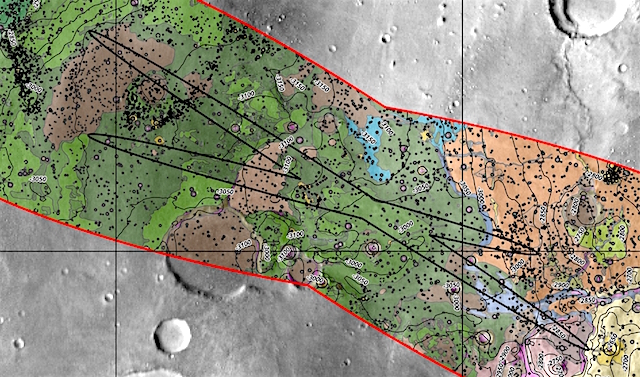-
Recent Posts
Archives
Links
general
mission instruments
- CRISM: Compact Reconnaissance Imaging Spectrometer for Mars
- CTX: Context Camera
- HiRISE: High Resolution Imaging Science Experiment
- MARSIS: Mars Advanced Radar for Subsurface and Ionosphere Sounding
- SHARAD: Shallow Radar
- THEMIS: Thermal Emission Imaging System
missions
- All Mars missions list
- Curiosity rover
- ExoMars
- Hope (al-Amal) orbiter
- InSight
- Mars Atmosphere and Volatile Evolution Mission (MAVEN)
- Mars Exploration Rovers (MER)
- Mars Express (MEX)
- Mars Odyssey
- Mars Orbiter Mission (MOM) / Mangalyaan
- Mars Reconnaissance Orbiter (MRO)
- Mars Science Laboratory (MSL)
- Perseverance Rover
- Tianwen-1 orbiter/rover
news
Weather update from Gale Crater
Posted in Reports
Tagged Curiosity, Gale Crater, Mars Science Laboratory, MSL, NASA, temperature, weather
Comments Off
Gathering the rocks of Meridiani Planum
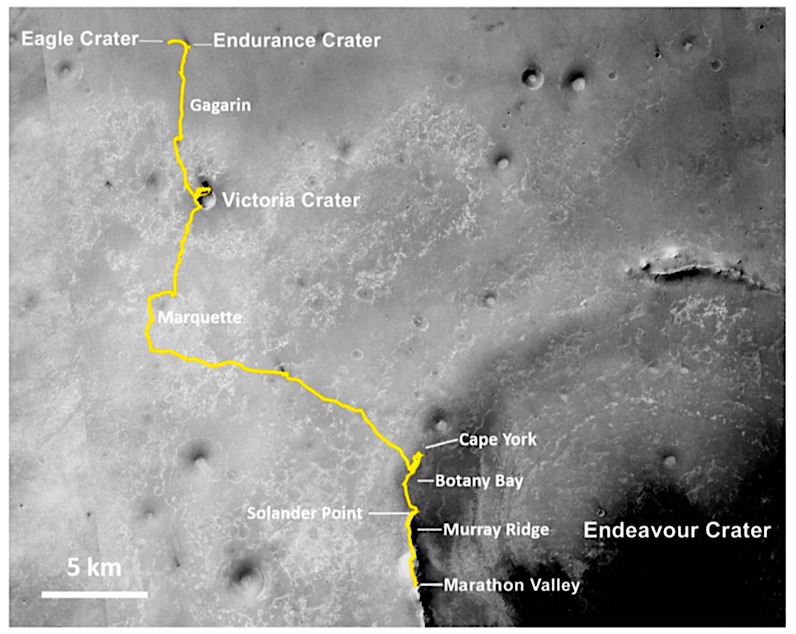 [Editor’s note: From a paper by Michael Bouchard and Bradley Joliff recently published in the Journal of Geophysical Research.]
[Editor’s note: From a paper by Michael Bouchard and Bradley Joliff recently published in the Journal of Geophysical Research.]
The Mars Exploration Rover Opportunity has been exploring the surface of the red planet since 2004 and has returned a huge amount of images and information. Part of this information is a data set of several hundred rock and soil chemical compositions.
This paper presents a method to quantify how similar each of these compositions is to each other, and to the composition of meteorites that we know came from Mars. These mathematical similarities are checked by using what is known about the rocks from images taken by the rover and ongoing geologic analysis.
These comparisons have led to new interpretations about the relationships between various rocks and rock groupings along the rim of Endeavour crater, a 22-km-diameter crater explored by Opportunity.
From the paper’s conclusion (emphasis added): We have used a set of statistical approaches to examine potential relationships among rocks analyzed by the MER rover Opportunity, focusing on members that have been mapped according to four major geologic formations, the Burns formation sulfate sandstones of Meridiani Planum, the Shoemaker breccias on the remnant rim of Endeavour crater, the Grasberg formation, an onlapping unit between the Burns formation and Shoemaker breccias, and the Matijevic formation, which may represent pre-Endeavour crater deposits exposed in a window in one of the rim segments… [More at link]
Posted in Reports
Tagged Botany Bay, Burns Formation, Cape York, Eagle Crater, Endeavour Crater, Endurance Crater, Gagarin, Grasberg Formation, Marathon Valley, Marquette, Mars Exploration Rover, Matijevic Formation, MER, Meridiani Planum, Murray Ridge, NASA, Opportunity, Shoemaker Formation, Solander Point, Victoria Crater
Comments Off
Curiosity update: We came, we science’d, we… still have a lot to do!
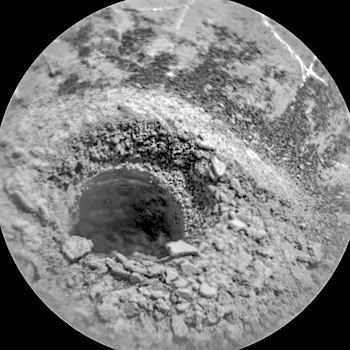 Sol 2226-28, November 9, 2018, update by MSL scientist Samantha Gwizd: As we enter this weekend thinking about football, raking leaves, and if you’re like me, sleeping a bit more, Curiosity will be gearing up for three sols of hard work! The science team will continue to characterize the drilled “Highfield” workspace by using ChemCam LIBS to examine the chemistry of the drill hole, seen in the above RMI image. This observation will supplement the mineralogical data to be obtained from CheMin soon!
Sol 2226-28, November 9, 2018, update by MSL scientist Samantha Gwizd: As we enter this weekend thinking about football, raking leaves, and if you’re like me, sleeping a bit more, Curiosity will be gearing up for three sols of hard work! The science team will continue to characterize the drilled “Highfield” workspace by using ChemCam LIBS to examine the chemistry of the drill hole, seen in the above RMI image. This observation will supplement the mineralogical data to be obtained from CheMin soon!
After the drill hole measurements, ChemCam will remain occupied with LIBS planned on targets “Rosebrae” (grey bedrock) and “Cullen” (an interesting combination of bedrock and mottled veins). The weekend science plan also includes a series of Mastcam change detection images to characterize wind-driven grain movement on sand targets “Sand Loch” and “Windyedge.” [More at link]
Posted in Reports
Tagged Aeolis Mons, Cullen, Curiosity, Gale Crater, Highfield, Mars Science Laboratory, Mount Sharp, MSL, Murray Formation, NASA, Rosebrae, Sand Loch, Vera Rubin Ridge, Windyedge
Comments Off
Sounds of a martian sunrise
Scientists have created the soundtrack of the 5,000th Mars sunrise captured by the robotic exploration rover, Opportunity, using data sonification techniques to create a two-minute piece of music.
Researchers created the piece of music by scanning a picture from left to right, pixel by pixel, and looking at brightness and colour information and combining them with terrain elevation. They used algorithms to assign each element a specific pitch and melody.
The quiet, slow harmonies are a consequence of the dark background and the brighter, higher pitched sounds towards the middle of the piece are created by the sonification of the bright sun disk.
Dr Domenico Vicinanza, of Anglia Ruskin University, and Dr Genevieve Williams, of the University of Exeter, will present the world premiere of the piece, entitled Mars Soundscapes in the NASA booth at the forthcoming Supercomputing SC18 Conference in Dallas (13 November)… [More at link]
Posted in Reports
Tagged Cape Byron, Endeavour Crater, Mars Exploration Rover, MER, NASA, Opportunity, Perseverance Valley
Comments Off
THEMIS: South polar ice cap textures
 THEMIS Image of the Day, November 12, 2018. This VIS image shows part of the south polar cap. This image was collected near the end of the southern spring season.
THEMIS Image of the Day, November 12, 2018. This VIS image shows part of the south polar cap. This image was collected near the end of the southern spring season.
Posted in Reports
Tagged Arizona State University, ASU, Mars Odyssey, NASA, south polar ice cap, THEMIS, THEMIS Image of the Day, Thermal Emission Imaging System
Comments Off
Curiosity: Peeking into Highfield
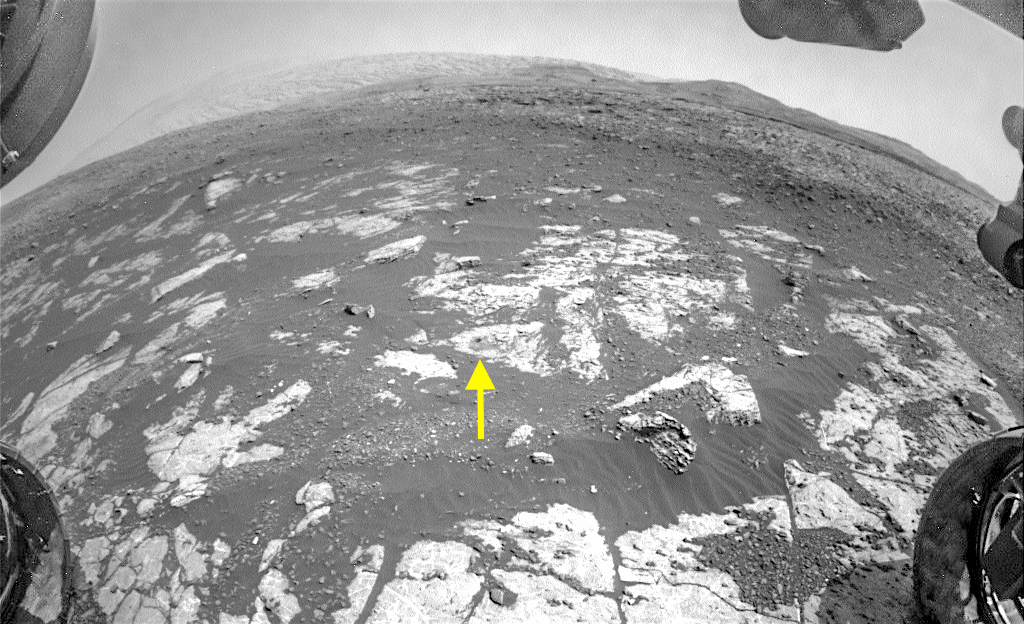
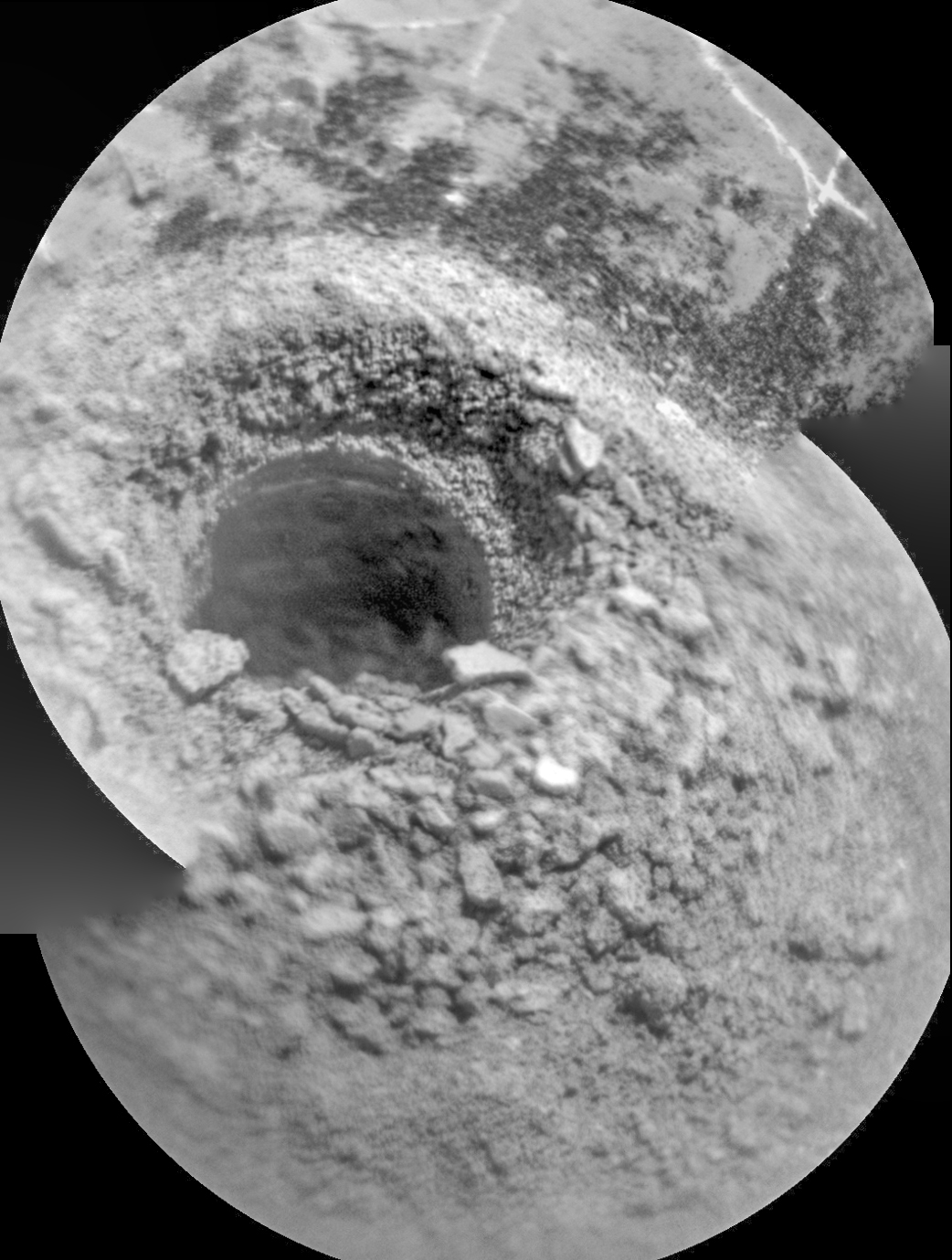 Sol 2225, November 9, 2018. Above is the front Hazcam view showing the location of the Highfield drill hole (arrow). Note Mt. Sharp on the skyline at left.
Sol 2225, November 9, 2018. Above is the front Hazcam view showing the location of the Highfield drill hole (arrow). Note Mt. Sharp on the skyline at left.
At right is a two-frame composite by the Remote Micro-Imager showing Highfield and a little of its interior surrounded by a pile of drill tailings. Click either image to enlarge it.
Posted in Reports
Tagged Aeolis Mons, Curiosity, Gale Crater, Highfield, Jura, Lake Orcadie, Mars Science Laboratory, Mount Sharp, MSL, Murray Formation, NASA, Vera Rubin Ridge
Comments Off
ExoMars: Oxia Planum landing site favored
[Ed. note: See also here.]
The ExoMars Landing Site Selection Working Group has recommended Oxia Planum as the landing site for the ESA-Roscosmos rover and surface science platform that will launch to the Red Planet in 2020. The proposal will be reviewed internally by ESA and Roscosmos with an official confirmation expected mid-2019. (…)
While the ExoMars Trace Gas Orbiter, launched in 2016, began its science mission earlier this year to search for tiny amounts of gases in the atmosphere that might be linked to biological or geological activity, the rover will drive to different locations and drill down to two metres below the surface in search of clues for past life preserved underground. It will relay its data to Earth through the Trace Gas Orbiter.
Both landing site candidates – Oxia Planum and Mawrth Vallis – preserve a rich record of geological history from the planet’s wetter past, approximately four billion years ago. They lie just north of the equator, with several hundred kilometres between them, in an area of the planet with many channels cutting through from the southern highlands to the northern lowlands. Since life as we know it on Earth requires liquid water, locations like these include many prime targets to search for clues that may help reveal the presence of past life on Mars.
“With ExoMars we are on a quest to find biosignatures. While both sites offer valuable scientific opportunities to explore ancient water-rich environments that could have been colonised by micro-organisms, Oxia Planum received the majority of votes,” says ESA’s ExoMars 2020 project scientist Jorge Vago… [Much more at link]
Posted in Reports
Tagged ESA, European Space Agency, ExoMars, ExoMars 2020, ExoMars 2020 rover, Mawrth Vallis, Oxia Planum, Roscosmos, TGO, Trace Gas Orbiter
Comments Off
Curiosity update: Science galore at the 18th hole
 Sol 2225, November 9, 2018, update by MSL scientist Claire Newman: Tosol we received confirmation that Curiosity’s drill yestersol was successful, as shown in this Navcam image of the “Highfield” target – our eighteenth drill hole in the martian surface!
Sol 2225, November 9, 2018, update by MSL scientist Claire Newman: Tosol we received confirmation that Curiosity’s drill yestersol was successful, as shown in this Navcam image of the “Highfield” target – our eighteenth drill hole in the martian surface!
Not quite a ‘hole in one,’ as we tried to sample the same gray Jura rock type about 50 sols ago, but we finally have a sample of our highest value target on Vera Rubin Ridge. Rather than retreat to the club house for a well-earned celebration, however, Curiosity and the team stayed busy in Sol 2225, doing Mastcam and ChemCam imaging of the new drill hole and tailings. This was in preparation for the weekend plan, in which there’ll be further imaging and ChemCam LIBS on the drill hole, and samples will be dropped off to CheMin for further analysis.
In addition, there’s a packed program of environmental science over the next few sols, now that we’re back to full science operations. The global dust storm may have decayed, but we’re still interested in seeing whether the post-storm atmosphere differs compared to the same season in previous Mars years… [More at link]
Posted in Reports
Tagged Aeolis Mons, Curiosity, Gale Crater, Highfield, Jura, Mars Science Laboratory, Mount Sharp, MSL, Murray Formation, NASA, Vera Rubin Ridge
Comments Off
HiRISE: Pitted material and mounds
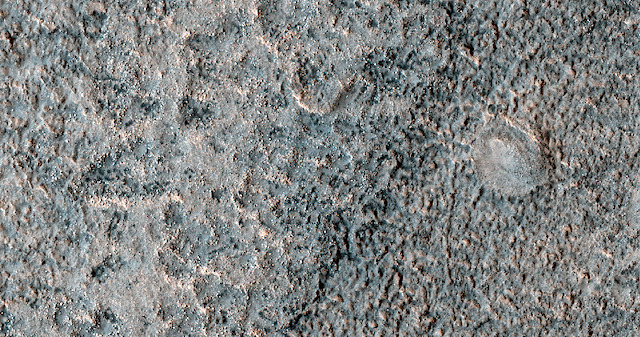 Pitted material and mounds in Chryse Planitia. This rough-looking material has many meter-length pits. What exactly is this stuff? Chryse Planitia shows evidence of water erosion in the past, and is the bottom end for many outflow channels from the southern highlands as well as from Valles Marineris and the flanks of the Tharsis bulge.
Pitted material and mounds in Chryse Planitia. This rough-looking material has many meter-length pits. What exactly is this stuff? Chryse Planitia shows evidence of water erosion in the past, and is the bottom end for many outflow channels from the southern highlands as well as from Valles Marineris and the flanks of the Tharsis bulge.
Beautiful Mars series. [More at links]
Posted in Reports
Tagged Beautiful Mars, Chryse Planitia, High Resolution Imaging Science Experiment, HiRISE, Mars Reconnaissance Orbiter, mounds, MRO, NASA, pits, Tharsis, University of Arizona, Valles Marineris
Comments Off
THEMIS: Channels flowing from a ridge
 THEMIS Image of the Day, November 9, 2018. This VIS image is located in Terra Sirenum. The bright linear feature at the bottom of the image is the crest of a ridge.
THEMIS Image of the Day, November 9, 2018. This VIS image is located in Terra Sirenum. The bright linear feature at the bottom of the image is the crest of a ridge.
The multiple channel features toward the top of this image were created by liquid flow running down slope from the ridge.
Posted in Reports
Tagged Arizona State University, ASU, channels, fluvial channels, fluvial landforms, fluvial processes, Mars Odyssey, NASA, Terra Sirenum, THEMIS, THEMIS Image of the Day, Thermal Emission Imaging System
Comments Off









